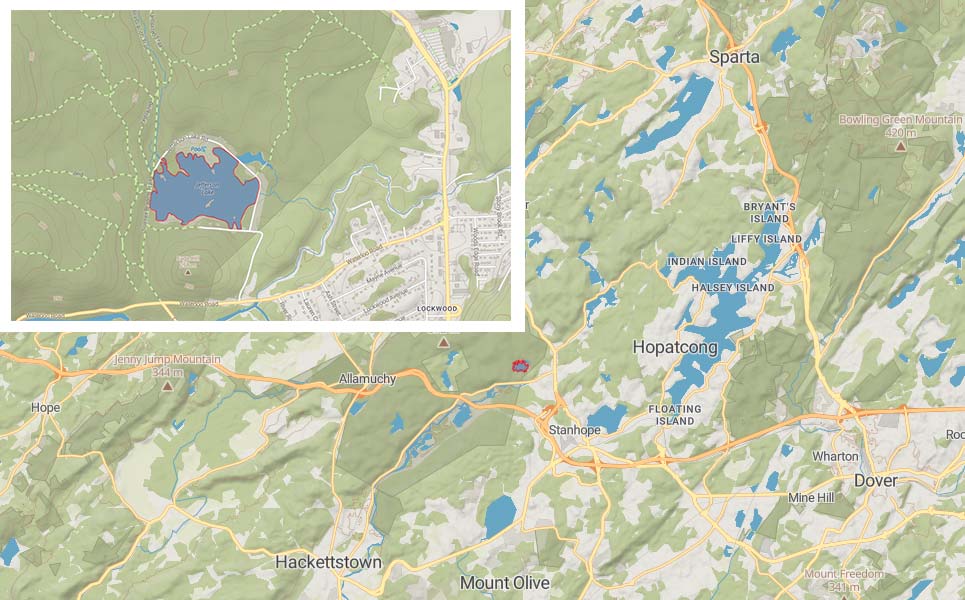Jefferson Lake is easily accessed by kayak or canoe. Car-topping a squareback canoe and mounting an electric motor on the stern is probably a better option than backing a trailer down the primitive launch. Casting from shore is extremely limited, and I don’t recommend coming here for that, but as I say, it’s an excellent spot for a kayak or canoe. The fishing is good. Pressure is relatively light. It’s likely you’ll be the only party there.
At 46 acres, it’s a classic small lake. New Jersey has quite a few of them – lakes of 40 or 50 acres where 3-pound bass are commonly caught during warmwater months. Jefferson doesn’t cut as high a profile as some when it comes to popularity, but you won’t find any landlocked salmon, trout, or muskies here, not even a Lunker Bass Lake designation. Such is what makes Jefferson worthwhile – relative anonymity. There’s a day camp for kids that operates in the back of the lake during summer, but it doesn’t make its presence felt much visually or by any noise. Not even the light traffic on Waterloo Road impinges on the quiet and the scene of wooded shores. No dam is visible. Water flows out of the lake under a bridge of the road to the camp.
Most of the open water is 8 to 10 feet deep, the deepest 12 feet. Since the water clarity is good, though not crystal clear, underlying weedbeds exist away from shore. Especially if you find submerged edges, positioning to retrieve along the length of them can be productive for crappies but also largemouth and pickerel. Small weedless jigs, particularly with 2-inch tubes or twisters, are productive for the crappies. Don’t rule out 1/8- or 1/16-ounce Johnson Beetle Spins. They’re like little spinnerbaits, but since the Colorado blades are small, they work effectively in the depths.

Crankbaits will collect weeds almost anywhere you cast, but worm rigs will produce away from the shorelines and right up against them. You can get fancy with weedless Carolina rigs, Ned rigs, etc., but just fishing a slow-sinking straight-tail worm with no weight added besides the hook is deadly. The more you imagine bass like the subtlety, the more they seem to respond. Rig one 8 inches long on a relatively small (light weight) 2/0 inset hook with the point buried in the plastic Texas style. Or fish a faster-sinking Senko rigged Wacky. Slip an open size 2 hook under an O-ring at the Senko’s center, and you will get away with that hook’s remaining clean more often than you might think, but you can use instead a weedless hook with a wire guard. Whichever worm rig you choose, make sure you let it sink to bottom.
Spinnerbaits and Chatterbaits are especially productive in those submerged weeds away from the shorelines, but my success with topwater plugs at Jefferson is in relation to visible targets, although some of these are not right up against the bank. Early and late in the day, under clouds, or in rain is best for plugging the surface or working a weedless frog in the pads. Otherwise, I’m throwing a worm and even after the sun comes out, I’ll catch bass.
The shorelines offer milfoil-type stringy weeds and in some places, pads. Work pad edges thoroughly, because they hold bass. Work from the edges inward. Retrieve a worm on top and let it drop into pockets. Use braid of at least 20-pound test. Brush in the water holds bass too – don’t be afraid to knock wood. The status quo of stringy weeds will produce as you work shorelines thoroughly, but always the exceptional spots you learn to know as you see them -they offer the most likely results and possibly the biggest bass. Mostly, you’ll catch largemouth at Jefferson; pickerel for some reason that escapes me are not as common, though they will take worms.
If I had the choice between investing all of my time fishing Jefferson’s shorelines, rather than any of the water out and away from them, I would stick to the shorelines – except I would fish any pad fields. They tend to grow from right at the edge to fairly well out from shore. The very largest bass in the lake may be vulnerable to your worm when you fish the outer edge of a pad field in relatively deep water.



